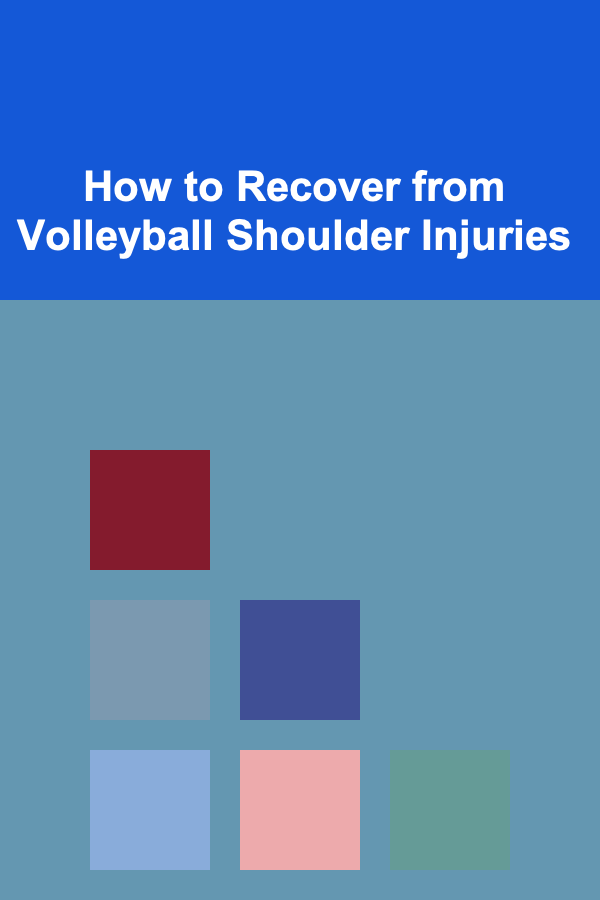
How to Recover from Volleyball Shoulder Injuries
ebook include PDF & Audio bundle (Micro Guide)
$12.99$11.99
Limited Time Offer! Order within the next:

Volleyball is an exhilarating and physically demanding sport that requires precision, agility, and strength. One of the most common injuries in volleyball is shoulder injuries, which can occur due to the repetitive motions involved in spiking, serving, and blocking. These types of injuries can significantly impact a player's performance and overall well-being. Recovering from a volleyball shoulder injury requires a multi-faceted approach that includes proper diagnosis, rehabilitation exercises, rest, and prevention strategies.
This article will provide a comprehensive guide on how to recover from volleyball shoulder injuries, covering the different types of injuries, rehabilitation techniques, prevention methods, and expert advice on managing recovery.
Types of Volleyball Shoulder Injuries
Shoulder injuries in volleyball can occur due to the constant overhead motions required by the sport. The repetitive nature of serving, spiking, and blocking puts significant stress on the shoulder joint, leading to various injuries. Below are the most common types of shoulder injuries encountered by volleyball players:
1.1 Rotator Cuff Injuries
The rotator cuff is a group of four muscles and tendons that stabilize the shoulder joint. These muscles are critical for shoulder mobility and strength, particularly in overhead movements. In volleyball, the repetitive motion of spiking and serving can cause strain or tears in the rotator cuff tendons. Rotator cuff injuries can range from mild strains to full-thickness tears.
Symptoms:
- Pain or weakness in the shoulder, especially when raising the arm overhead
- Limited range of motion
- Swelling or inflammation around the shoulder joint
- Difficulty sleeping on the affected shoulder
1.2 Shoulder Impingement
Shoulder impingement occurs when the tendons of the rotator cuff become pinched between the humerus (upper arm bone) and the acromion (the bony prominence on the shoulder blade). This condition is often caused by repetitive overhead motions in volleyball. Impingement can result in inflammation, irritation, and pain in the shoulder.
Symptoms:
- Pain when reaching overhead or lifting the arm
- Tenderness on the front or side of the shoulder
- Decreased strength and range of motion
- Pain that worsens with activity
1.3 Labral Tears
The labrum is a cartilage structure that forms a cup around the shoulder socket to provide stability. A labral tear occurs when the labrum becomes torn, often as a result of repetitive overhead motions or a direct impact to the shoulder. Labral tears are more common in athletes who engage in sports that require overhead movements, like volleyball.
Symptoms:
- Deep shoulder pain, particularly in the front or back of the shoulder
- A popping or clicking sensation in the shoulder
- Weakness and instability in the shoulder joint
- Limited range of motion
1.4 Shoulder Sprains and Strains
A shoulder sprain involves the overstretching or tearing of ligaments, while a strain refers to the overstretching or tearing of muscles or tendons. Both sprains and strains can occur in volleyball players due to the high-impact nature of the sport, such as diving for the ball, blocking at the net, or the repetitive stress placed on the shoulder.
Symptoms:
- Pain and tenderness in the shoulder area
- Swelling and bruising
- Difficulty moving the shoulder or using it for normal activities
- Muscle weakness
1.5 AC Joint Injuries
The acromioclavicular (AC) joint connects the clavicle (collarbone) to the acromion (part of the scapula). AC joint injuries can occur when there is trauma or repetitive stress on the shoulder, leading to inflammation or separation of the joint. These injuries are common in volleyball players who experience falls or collisions during play.
Symptoms:
- Pain at the top of the shoulder
- Swelling or bruising over the AC joint
- Difficulty lifting the arm
- Instability or a "popping" sensation in the shoulder
Steps for Recovering from Volleyball Shoulder Injuries
Recovering from a volleyball shoulder injury requires a step-by-step approach that focuses on reducing pain, restoring strength, and preventing further damage. Below are the key steps involved in recovery:
2.1 Rest and Ice Therapy
The first step in recovering from any shoulder injury is allowing the injured area to rest. Overusing the shoulder after an injury can lead to further damage and prolonged healing. During the initial phase of recovery, it is important to avoid activities that cause pain and strain on the shoulder.
Ice Therapy:
- Apply ice to the injured shoulder for 15-20 minutes every 2-3 hours during the first 48 hours after the injury.
- Ice helps reduce swelling and inflammation, which is crucial in the early stages of recovery.
- Use a cold pack, ice wrapped in a cloth, or a frozen gel pack to avoid direct contact with the skin.
Resting the shoulder and utilizing ice therapy can significantly speed up the healing process by reducing pain and inflammation.
2.2 Pain Management
Managing pain is a crucial aspect of the recovery process, particularly in the initial stages. Pain can impede the rehabilitation process by limiting your range of motion and strength. Over-the-counter anti-inflammatory medications, such as ibuprofen or naproxen, can help alleviate pain and reduce swelling. However, these medications should only be used as directed and under the guidance of a healthcare professional.
For more severe pain, your doctor may recommend prescription medications or other forms of pain relief, such as corticosteroid injections, to reduce inflammation and pain.
2.3 Physical Therapy
Once the initial pain and inflammation have subsided, physical therapy plays a vital role in the recovery process. A physical therapist will guide you through a series of exercises designed to restore mobility, strength, and stability to the shoulder joint. These exercises help improve the range of motion, correct muscle imbalances, and prevent future injuries.
Key Physical Therapy Techniques:
- Stretching: Gentle stretching exercises can help improve flexibility and restore the shoulder's range of motion. Stretching the rotator cuff, deltoids, and chest muscles is particularly beneficial.
- Strengthening: Strengthening exercises focus on the muscles surrounding the shoulder joint, such as the rotator cuff muscles, deltoids, and scapular stabilizers. Strengthening these muscles will help prevent re-injury and improve shoulder function.
- Stabilization Exercises: These exercises target the muscles that stabilize the shoulder joint. Exercises such as scapular retraction, shoulder shrugs, and external rotations can improve the stability and functionality of the shoulder.
- Proprioception: This technique involves exercises that help improve the body's sense of joint position. Proprioception exercises help improve coordination and control, especially when the shoulder is in motion.
2.4 Gradual Return to Play
Once you've completed the rehabilitation process and your shoulder is functioning normally, it is important to gradually return to play. Rushing back into volleyball after an injury can lead to re-injury or additional strain on the shoulder.
Return-to-Play Strategy:
- Start with light activities: Begin with low-impact activities such as swimming or cycling to build strength and endurance in the shoulder.
- Reintroduce volleyball drills: Slowly ease back into volleyball by performing controlled drills, such as serving, passing, and setting, before progressing to more intense activities like spiking and blocking.
- Monitor pain: Pay close attention to any discomfort or pain during activities. If you experience pain, stop and consult with your therapist or doctor before proceeding further.
- Use protective gear: If recommended, consider using a shoulder brace or support to protect the injured area as you return to full activity.
2.5 Preventing Future Injuries
Once you've fully recovered, the focus shifts to preventing future shoulder injuries. Volleyball players are particularly susceptible to shoulder injuries due to the repetitive nature of the sport. Preventative measures are essential for maintaining shoulder health and ensuring long-term success in the sport.
Prevention Tips:
- Warm-up and cool-down: Always perform a proper warm-up before playing and cool down afterward to prepare your shoulder for physical activity and promote flexibility.
- Strengthen the shoulder muscles: Consistently perform shoulder strengthening exercises, particularly for the rotator cuff and scapular muscles, to build muscle resilience and support the shoulder joint.
- Improve biomechanics: Work with a coach or therapist to improve your technique, especially when spiking, serving, and blocking. Poor form can put excessive strain on the shoulder joint.
- Cross-training: Incorporate cross-training activities, such as swimming or weightlifting, to improve overall strength and reduce the risk of overuse injuries.
Conclusion
Shoulder injuries are common in volleyball, but with proper care, recovery is possible. The key to recovering from a volleyball shoulder injury is a combination of rest, ice therapy, pain management, physical therapy, and a gradual return to activity. In addition, taking steps to prevent future injuries, such as strengthening the shoulder muscles and improving technique, is crucial for maintaining shoulder health and prolonging your volleyball career. By following these steps and working with a medical professional, you can recover from your shoulder injury and return to the court stronger than before.
Reading More From Our Other Websites
- [Personal Care Tips 101] How to Use Hair Mousse for a Beachy, Textured Look
- [Personal Financial Planning 101] How to Understand Capital Gains Tax and Minimize Its Impact
- [Personal Finance Management 101] How to Set Up a Financial Calendar for the Year
- [Home Budget 101] How to Master the Zero-Based Budget: Every Dollar Accounted For
- [Weaving Tip 101] Weaving Wellness: How the Art of Tapestry Reduces Stress and Boosts Creativity
- [Beachcombing Tip 101] DIY Sea Glass Crafts: Transforming Beach Finds into Home Décor
- [Home Space Saving 101] How to Implement Open Shelving Ideas to Showcase Your Personality and Maximize Space: A Room-by-Room Guide
- [Home Renovating 101] How to Maximize Your Home's Space with Creative Storage Solutions
- [Horseback Riding Tip 101] From Hobby to Career: How to Turn Your Passion for Horse Riding into a Full-Time Job
- [Home Budget Decorating 101] How to Style Your Bookshelves on a Budget

How to Create and Maintain a Family Book Club
Read More
How to Reduce Inventory Holding Costs with Effective Management
Read More
How to Use Hidden Storage to Keep Your Home Organized
Read More
How To Understand the Basics of Black Holes
Read More
How to Identify Quasars
Read More
How to Vote While Living Abroad: A Comprehensive Guide
Read MoreOther Products

How to Create and Maintain a Family Book Club
Read More
How to Reduce Inventory Holding Costs with Effective Management
Read More
How to Use Hidden Storage to Keep Your Home Organized
Read More
How To Understand the Basics of Black Holes
Read More
How to Identify Quasars
Read More